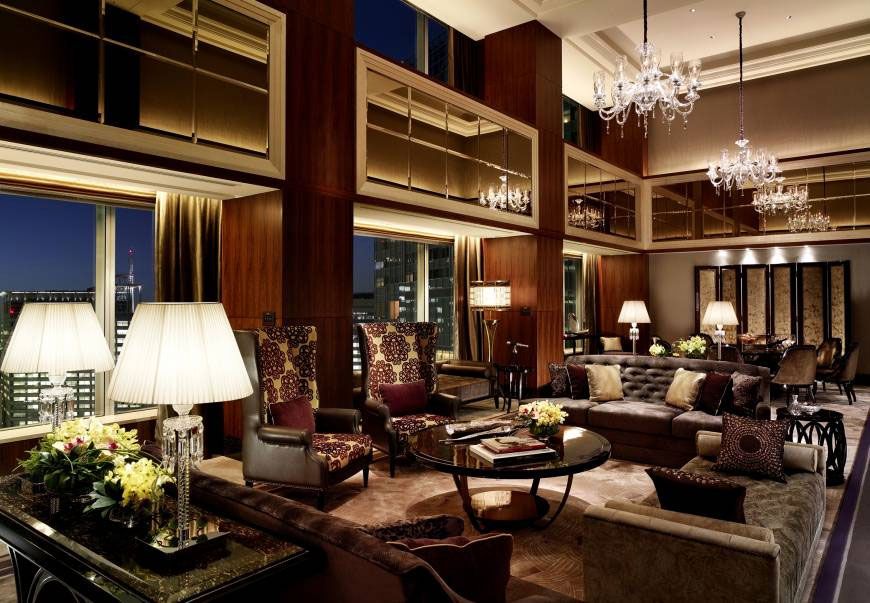
Twenty nine is a pretty big number when referring to hotel openings, but Shangri-La Hotels and Resorts, the legendary Asian brand started in Singapore in 1971, is opening that many properties within the next three years. At this pace, I surely won't be able to keep up unless I commit to seeing about one hotel a month! The rapid expansion is no less a testament to the Shangri-La's nearly five decade mastery of luxury hospitality the world over. On a recent tour of Asia's island countries, I had the chance to stay at two Shangri-La Hotels in Tokyo and Manila. Exquisite and distinct, each property deserves a visit for its outstanding attributes.

Shangri-La Hotel, Tokyo
I've always loved the intricacy of Japanese design in which details are imperative in creating luxury. The Shangri-La Hotel, Tokyo embodies a level of detail such that the hotel is nearly a stand-alone attraction even within densely dazzling Tokyo. Fifty regal chandeliers, dozens of flower arrangements and a 2,000-piece art collection make a tour of the hotel last for at least two hours. I fully enjoyed this unique merger of various artworks within an outstanding hotel in the heart of the city.

Nicolai Bergmann, a celebrated floral designer in Japan and Scandinavian native, adorns the property daily with dozens of his arrangements. The hotel remains the one of the top places in the world to showcase Bergmann's arrangements both publicly and in-room. Stunning and intricate, Bergmann's petal works literally make guests "stop and smell the roses.” It’s a year-long Ohanami, a Japanese springtime flower viewing tradition. I believe its Bergmann’s intention to provide tranquility and quiet reflection, a rarity in a metropolis like Tokyo.

The chandeliers within the hotel are just as captivating as the flowers. Twenty of the hotel's 50 chandeliers were specifically made for the property and each was handmade with crystals from the Czech Republic. One chandelier I particularly admired was the 10 meter-long “waterfall" work in the Grand Staircase by Tána Dvorákova. More than 480,000 crystal beads cascade down several floors, mimicking rain droplets falling in gleaming sunlight. In the Lobby Lounge, a rectangular chandelier made with hand-blown glass gingko leaves—a revered symbol in Tokyo—is eye-catching, particularly in late afternoon.

Also, the art collection at the Shangri-La Hotel, Tokyo is a thoughtful and compelling compilation of works inspired by the eminent Chinese poet from the Tang Dynasty, Bai Juyi. Juyi's works encompass more than 2,500 poems, some of which detailed a far-off fairytale land called Shangri-La. The collection includes Anthony Davy's massive gilded panel made with palladium and gold and Etsuko Ichikawa's pyrography series, a traditional art that uses heated instruments to burn designs onto cotton paper.

Makati Shangri-La, Manila
As I’ve written before, there is a natural hospitality within the Philippines. This grace was particularly noted at Makati Shangri-La, Manila, one of the city's grandest properties. Similar to the Tokyo location, the Manila hotel is surrounded by the city's most desirable attractions, such as the mega malls Makati has become known for. The entire hotel radiates grandeur with epic staircases, stories-high columns and sweeping views of Makati. A stay within the Horizon Club offers yet another level of Shangri-La luxury. Each Shangri-La I have visited offers the Horizon Club, but I particularly noticed the attention and exclusivity of this setting.

The Horizon Club starts with a personal greeting at the airport, which is always a nice relief after long international travel. A 20-minute drive from the airport took my guest and I to the red carpet lobby reception doors of the Makati Shangri-La, Manila. Several people greeted us warmly, a reception sometimes uncommon at larger hotel. I quickly checked in at the Horizon Club’s separate reception desk on another floor of the massive hotel, stealing glances at the impressive cityscape beyond the club’s windows.

Amenities at the Horizon Club are just the kind to alleviate the stress sometimes endured in clamoring, manic cities like Manila. Every day, guests can request an in-person wake-up call served with a hot beverage of choice. A stunning daily breakfast buffet awaits guests in the private lounge, and meetings in the comfortable conference rooms can be held upon request. The concierges of the Horizon Club helped arrange unique explorations of the expansive city. I was able to watch an authentic (and legal) cockfight and bike along the cobblestone alleys of the former walled city Intramuros.

After busy days of excursions, flawlessly arranged, it was a welcoming reprieve to arrive back at the lounge where cocktails and an unfurling of delectable canapés awaited my guest and me. This level of service is what makes Makati Shangri-La, Manila worth a visit.









